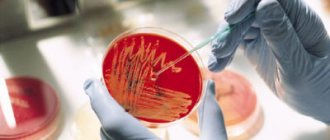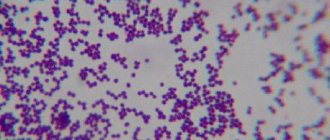All expectant mothers know how important a urine test is during pregnancy. It helps control the condition of the genitourinary system, stop inflammatory diseases and a number of other negative processes at an early stage. Therefore, the appearance of an element such as staphylococcus in the urine during pregnancy can be a serious cause for concern.
You should know that it does not always make sense to sound the alarm when this bacterium is detected. Staphylococcus itself belongs to the category of opportunistic microflora and is usually facultative for humans. It is a permanent inhabitant of human skin, and sometimes settles on the mucous membranes (in the mouth, nose, genitourinary system, intestines and vagina), where it carries out life activities that do not cause harm.
The microorganism is constantly present in the mucous membranes of 20% of the population and can occasionally appear in the other 80%. A threat to the health of a pregnant woman appears only when the bacterium begins to multiply rapidly, causing inflammatory reactions.
Staphylococcus during pregnancy
Detection of a microorganism in tests during pregnancy does not always require immediate antibacterial treatment. First, the doctor studies the quantitative content of the bacterium, subtype and location, after which he makes a conclusion about the need for therapy.
Types of staphylococcus
Scientists identify 27 varieties of staphylococcus. Of these, many can live in the human body, but only 4 species pose a real threat to the expectant mother and her fetus:
- Saprophytic. Usually found on the genitals and mucous membranes of the urinary tract, feeding on dead biomaterial. Under normal conditions, it is not dangerous, but it can aggravate the course of inflammatory diseases of the genitourinary tract. When bacteria multiply excessively, they begin to move up the urinary tract and can cause diseases such as urethritis, cystitis or pyelonephritis.
- Epidermal (skin). This species lives on the surface of the skin and mucous membranes, but when it enters the bloodstream through cuts and abrasions, into the stomach along with unprocessed food, or into the mucous membranes of the genital organs through sexual contact. Can cause inflammatory processes in internal organs with the formation of pus. The detection of Staphylococcus epidermidis in the analysis does not often indicate a threat to health.
- Hemolytic. When staphylococcus haemolyticus is discovered, it is important to know that this species is dangerous in its unpredictability, since it can multiply on the mucous membranes of any organs, causing dangerous purulent lesions.
- Golden. This type is the most common of all and the most dangerous for pregnant women. Like hemolytic, it can cause purulent inflammation in any organs and tissues, but it is highly resistant to drugs and requires longer therapy. Most often, the detection of Staphylococcus aureus in the urine becomes the basis for treatment.
Causes of staphylococcus
The bacterium enters the body in different ways - through air, food, sexual contact, or through blood from wounds or surgery. However, staphylococcus becomes dangerous during pregnancy only when bacteria multiply excessively.
Factors in the development of the infectious process are:
- decreased immunity due to acute and chronic diseases, previous operations, stress, insomnia or hypothermia;
- presence of AIDS or immunodeficiency virus;
- lack of hygiene;
- endocrine system disorders;
- bad habits (smoking, drinking alcohol).
Risks accompanying staphylococcus
The proliferation of staphylococci is associated with a number of risks. By parasitizing the mucous membranes, bacteria are capable of damaging and destroying blood cells and the immune system, causing allergies and inflammatory processes, and also releasing toxins that destroy tissue cells.
Depending on the location, these microorganisms can cause the following pathologies:
- purulent processes in the skin: microbial eczema, carbunculosis, boils;
- damage to the upper respiratory tract: microbial pharyngitis, sore throat, abscesses in the pharynx;
- inflammatory diseases of the mucous membranes and tissues: conjunctivitis, blepharitis, vulvovaginitis, secondary microbial rhinitis;
- diseases of the genitourinary system: cystitis, urethritis, nephritis;
- diseases of bones and tissues: osteomyelitis, mastitis.
Possible complications
Late detection or delay in treatment of staphylococcus threatens a number of complications for the health of the mother and baby.
With improper therapy, the condition can progress to severe purulent organ damage, peritonitis and diseases such as pneumonia and meningitis. If the infection enters the general bloodstream, it can lead to septicopyemia, in which purulent foci are formed throughout the body, and inflammation of the inner lining of the heart, which can be fatal.
Staphylococcal infection has both direct and indirect negative effects on the unborn baby. The health of a child of an ill mother is associated with the following risks:
- complication of childbirth;
- fetal hypoxia;
- disruption of the intrauterine development of the unborn baby due to the use of potent drugs;
- intrauterine infection due to bacterial damage to the membranes (after delivery, painful spots and blisters similar to burns are present on the newborn’s skin).
What are the risks for a pregnant woman and her unborn baby?
Bacteria accompany us at every step: in dust, in clothes, on shoes, in general - on everything that surrounds us. Almost every person on Earth has encountered staphylococcus.
Human immunity most often copes with most attacks without giving pathogenic flora a chance to multiply, so we don’t even know that we are carriers of one or another type of bacteria.
However, during pregnancy, the body weakens the protective functions of the immune system in order to prevent fetal rejection and preserve pregnancy. It is at this moment that staphylococcus goes on the offensive.
What is the threat of a staphylococcal infection for the expectant mother and fetus?
- Like any bacteria, staphylococci release toxins into their environment, which are quite aggressive and can cause skin lesions (pemphigus of newborns).
- There is a high risk of infection of the amniotic sac itself.
- There is a high probability of complications of an infectious nature in a woman after.
- There is a risk of infection of the mother's mammary glands, which can cause mastitis, which in turn increases the risk of infection of the baby through milk.
- The bacterium can provoke the development of peritonitis, pneumonia and other dangerous diseases, the treatment of which during treatment is associated with enormous risks for the intrauterine development of the fetus.
Diagnosis of staphylococcus in urine in pregnant women
Staphylococcus can be detected in the urine of pregnant women only by performing a bacteriological culture test. However, the presence of an inflammatory process can also be assumed by a number of symptoms.
Symptoms of staphylococcus in urine
Symptoms caused by staphylococcus do not have clear specifics and can be characteristic of many diseases caused by other pathogens. The two main signs that accompany the proliferation of a microorganism are pus and fever. If these symptoms are absent, then staphylococci can be excluded.
Other manifestations of the disease, depending on the location, include:
- pain and burning when urinating;
- purulent formations on the skin;
- chills and fever;
- pain and sore throat with the formation of ulcers;
- stomach and intestinal disorders;
- aching pain in the lower abdomen or lower back;
- redness and swelling in the area of the affected organs.
Regardless of the pathogen, these symptoms require prompt examination.
What can you get infected from?
Staphylococcus exists in the environment, soil, on the surfaces of objects, in the saliva of a person who is a carrier, so infection can occur in various ways.
- By contact, with close bodily contact, when using shared means and hygiene items.
- By airborne droplets (this is how hospital-acquired pneumonia most often spreads).
- Through contaminated food and utensils;
- When using non-sterile medical instruments.
Analysis for the determination of staphylococcus
If a staphylococcal infection is suspected, the doctor prescribes a general blood test to determine the degree of the inflammatory process, culture of vaginal discharge and urine, as well as an examination of the upper respiratory tract.
Gynecological smear
Analysis of a gynecological smear is very important in diagnosing staphylococcus. Detection of bacteria in quantities exceeding the norm requires prompt treatment so that the birth canal is safe for the unborn baby.
If the number of microorganisms is less than 1000 in the field of view, therapy, as a rule, is not prescribed, but if the golden variety is detected, the gynecologist may make a different decision.
Urine examination
Detection of bacteria in urine culture is very important for the prevention of genitourinary tract diseases. Most often, a saprophytic subtype is found in the urine, but even if staphylococcus is normal, the doctor may recommend gentle treatment in the 2nd and 3rd trimesters of pregnancy.
Such measures are associated with a high load on the kidneys and ureters during the period of intensive fetal growth. Compression of organs causes stagnation of urine and pyelonephritis in pregnant women, due to which bacteria can become pathogenic for the body and contribute to the development of the disease.
Analysis of ENT organs
The upper respiratory tract is usually examined symptomatically if conventional treatment fails. During the examination, swabs are taken from the mucous membranes of the throat and nose. As a rule, an analysis for staphylococcus in the ENT organs detects non-aggressive hemolytic, and less often, Staphylococcus aureus. In the absence of complications, treatment is simple and highly effective.
Complications
Complications of staphylococcal infection occur when the problem is ignored. If treatment is not started on time, this may result in:
- endocarditis;
- meningitis;
- toxic shock;
- blood poisoning.
In the first case, the heart valves are damaged, the person experiences pain in the joints, the heartbeat increases, and performance decreases.
With meningitis, there is an increase in temperature, nausea with vomiting, and headache. Staphylococci cause suppuration of the membranes of the brain. And even with timely treatment, death is possible in 30% of cases.
Toxic shock syndrome is considered one of the symptoms of staphylococcal infection, or rather a sign of complications. With it, a person’s body temperature rises to 40 degrees, diarrhea and vomiting are observed, and blood pressure decreases.
Blood poisoning occurs when bacteria enter the bloodstream, where they begin to multiply and poison the blood with toxins. Sepsis is the most common type of infection, which is also considered the most dangerous.
Treatment of staphylococcus
Treatment of bacterial pathology is carried out individually, based on the type of microorganism, location and duration of pregnancy.
Typically, doctors try to prescribe medications without side effects and avoid antibiotics. The treatment in such cases includes:
- taking bacteriophages (such drugs do not pose a health risk);
- use of immunomodulatory agents and complexes of vitamins and minerals;
- rinsing and douching of mucous membranes.
Antibiotics are prescribed in extreme cases, such as the growth of Staphylococcus aureus and severe inflammatory processes, when the benefits outweigh the possible risks. To protect the intestinal microflora, antibacterial therapy is combined with the intake of probiotics.
Disease prevention
Prevention of diseases caused by staphylococci does not require special measures, the main thing is to minimize the impact of factors causing the infectious process, namely:
- strengthening the immune system by following a daily routine (good rest, balanced nutrition, moderate physical activity) and taking vitamin and mineral complexes;
- timely treatment of chronic and acute diseases;
- maintaining personal hygiene;
- timely antiseptic treatment of skin lesions;
- regular monitoring by your doctor.
Instead of this phrase, insert your own phrase that you want to highlight. Or insert links in a list to create a linking block.









